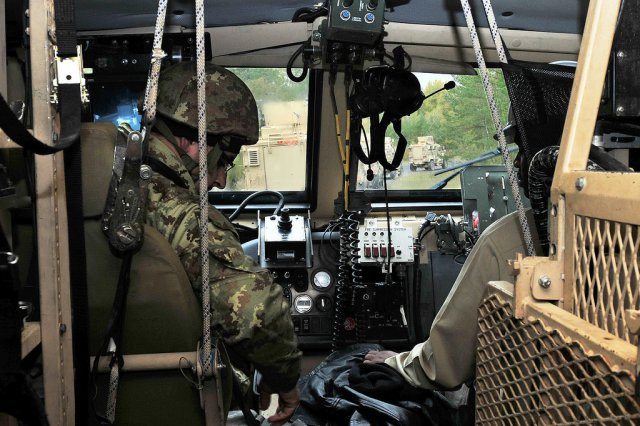Early in the evening of Oct. 20, Italian combat engineer Cpl. Tizano Testa hurriedly clamored over the cab of a 19-ton, 18-foot high MaxxPro-Base armored fighting vehicle while trying to install a night-vision camera on the roof.
The soldier behind the wheel of the massive vehicle, Francesco Monteforte, was waiting to drive through the motor pool parking lot with the windshield armor down — essentially driving in a steel box without a window — and needed the camera to see.
“The way you drive at home, there should be no difference if I attach it or not!” said Testa sarcastically. Within a few minutes the wind picked up and it began to rain. At this time of year the late afternoon light fades fast, making the task of getting the camera properly attached and functioning even more difficult.
“Can you see anything yet?” Testa called out in English, heavily accented in a Neapolitan-Italian dialect. He was obviously impatient to get moving. As an afterthought, he added a few sharp words in Italian intended for the camera.
Finally, Monteforte called out from inside the vehicle: “Wait! It’s good — I see! Avanti! Let’s go!”
Testa and Monteforte are two of the 32 students from the 21st Engineers, members of the Italian Combat Service Support Battalion based out of Caserta, located approximately 40 miles north of Naples, who came to the U.S. Army Europe Joint Multinational Training Command to attend a two-week intensive mine-resistant, ambush-protected, or MRAP, vehicle driver/operator certification course.
“Even though it’s already getting pretty dark, they shouldn’t be taking so long to get moving,” said Aubrey Gorden, lead instructor and multinational training specialist in charge of the JMTC MRAP driver certification program. “But they’ll cut that time in half tomorrow. I’ve rarely taught a group with such a high learning curve — and I’ve been working with multinationals my entire career.”
Gorden climbed into the passenger seat next to a confident, smiling Monteforte. Throughout the training an instructor rides in each vehicle with a group of students to ensure they are safely operating the vehicle, which involves backing, three-point turns, serpentine figure eights, quick stops and starts, obstacle navigation and real-life scenarios they may confront in combat.
In order to receive their certification and MRAP license, students are required to log a minimum of 50 miles of daytime driving and 30 miles at night using both night-vision video cameras and standard headlights separately. Prior to certification, students must demonstrate proficiency driving the vehicle, know its capabilities, safety and general operating features as a passenger, as well as a driver, and identify the required tasks and warning gauges in order to keep up with the vehicle’s general maintenance.
“Grafenwoehr has everything we need to really train a Soldier well in such a short period of time,” said Anthony Orejel, a certification instructor, referring to the training area’s terrain and road conditions.
“The Italian language is a difficult hurdle, of course, but we quickly got over it,” said Gorden with a chuckle. “We teach multinationals from virtually every corner of the world, but the nature of teaching is to learn, so we adapt to how each group of students learn best — that’s part of making any successful program work. The main thing is to ensure that all students we teach are properly certified and have the training to safely and expertly operate the vehicle in combat.”
Since the program’s inception in 2009, the training has grown to cover not only driving various types of MRAPs but also safety, rollovers, recovery and maintenance. Initially, the course was intended for U.S. Soldiers only, but when NATO and allied multinational partners requested training JMTC was all too happy to open the program up to them. In the last three years JMTC has evolved into a place where U.S. Soldiers and their coalition counterparts from all over the globe learn how to work together.
The MRAP is an armored fighting vehicle outfitted with a sophisticated array of improvised explosive device, or IED, countermeasures and safety features. The vehicle is designed with a V-shaped hull that deflects the blast of an IED or land mine away from the vehicle, and suspension floors and seats that reduce injuries caused by an explosive’s shockwaves. The 10-ton armored body is bolted together instead of welded to the vehicle’s chassis to facilitate quick repairs.
Italian Cpl. Fabiana Gatta had only praise for the vehicle’s performance on the range — no small flattery from a citizen of a land famously known for its love of high-performance automobiles, renowned champion Formula-1 drivers and gridlocked city squares.
“It’s pretty fast. Sitting up so high you sometimes don’t become aware how fast you are going until the instructor tells you to ‘slow it down!’ The steering is a lot smoother than you would imagine. I could even drive this through rush hour time in downtown Naples, no problem!” he added with a laugh. “After this training I could get through with no dents, you know, that would be a first for me in my town!”
In October, JMTC hosted a Full-Spectrum Training Exercise, or FSTE, with over 5,200 U.S. and multinational troops taking part, one of the largest coalition exercises to take place in Europe since the last Return of Forces to Germany, known as REFORGER, in May of 1993. In 2011 alone, JMTC instructors trained over 22,000 multinational troops from 38 countries.
“JMTC is the place for combined U.S. and multinational training and we are exceptionally good at it,” said Col. Curtis J. Carson, JMTC chief of staff. “The conflicts faced today do not allow for a quick, seamless transition to effective partnership except through training. We’re building tomorrows coalitions today, right here at JMTC.”










